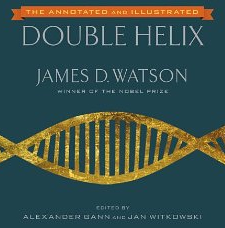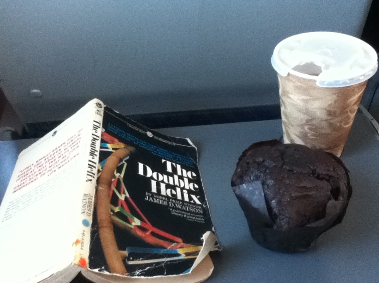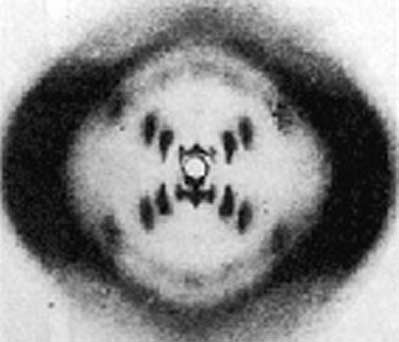Last week I had some traveling to do and took the opportunity to reread a classic. The Double Helix is James D. Watson’s personal account of the discovery of the structure of DNA (1953), for which he, Francis Crick, and Maurice Wilkins were awarded the Nobel Prize in 1962. It’s a relatively quick read, dwelling less on science and more on the research atmosphere in post-WWII England and the struggles of those involved in the race to discovery DNA’s structure, including Rosalind Franklin, Erwin Chargaff, Linus Pauling, and other famous names from genetics textbooks. If Dr. Watson is anything as a writer, he is straightforward, and his unflinching account of the events is just fascinating.
Watson and Crick
Watson met Crick at the Cavendish Laboratory (Cambridge University) in 1951, when he (Watson) came over from the U.S. on a fellowship to join a small group of researchers working on the structure of proteins. At the time, physicists and chemists around the world were rapidly engaged in solving the structures of important biological molecules, aided enormously by the development of X-ray crystallography techniques pioneered by William Astbury. One of the world’s leading chemists, Linus Pauling (Caltech), had used X-ray images of proteins to determine that their secondary structure formed a helix (the alpha-helix). Proteins were a hot topic, and the world wasn’t yet convinced that DNA had an important role to play.
A Shared Interest in DNA
Watson, by his own admission, was wandering around Europe (ostensibly to learn biochemistry) and trying to find something that really interested him. His background was virology; a field serendipitously connected to the transfer of genetic material in the form of DNA. At Cambridge, Watson and Crick immediately struck up a friendship fueled by their mutual interest in DNA. They wanted to work on it but encountered a delicate situation: Maurice Wilkins and Rosalind Franklin, of King’s College in nearby London, had been working on that problem for some time, hoping to solve it through X-ray crystallography.
In England there were certain unspoken rules about entering an area of research already staked out by a colleague. In the book’s introduction, Sir Lawrence Bragg (head of the Cavendish Laboratory at the time) described the situation:
“The story is a poignant example of a dilemma which may confront an investigator. He knows that a colleague has been working hard for years on a problem and has accumulated a mass of hard-won evidence, which has not yet been published because it is anticipated that success is just around the corner. He has seen this evidence and has good reason to believe that a method of attack which he can envisage, perhaps merely a new point of view, will lead straight to the solution. An offer of collaboration at such a stage might well be regarded as a trespass.”The dilemma was even more troublesome because Maurice Wilkins and Rosalind Franklin were having their own problems getting along.
False Starts, Dead Ends, and Linus Pauling
The relationship with Wilkins and Franklin got off to a poor start. Watson and Crick had built a [grossly incorrect] model of DNA in which the nucleotides were on the outside, and invited the King’s College pair to come and see it. Franklin was convinced that the sugar-phosphate backbone must be on the outside of the molecule, and Wilkins believed her. They were quick to point out the faults of the doomed phosphate-in model, and also rather offended that these two upstarts were trespassing on their area of research. It was a huge debacle, after which Watson and Crick were told (by the head of their laboratory) to stay away from DNA.
Meanwhile, everyone was watching Linus Pauling and holding their breath. He’d already solved the alpha helix, and was actively working to solve DNA’s structure. There was a moment of dread when the group in England got word that Pauling had submitted a paper proposing DNA’s structure as a triple helix. Watson and Crick managed to get an early look at this through Pauling’s son, who was currently their office-mate. They immediately saw obvious flaws in Pauling’s proposed model — it was wrong — but they knew it was only a matter of time until he came up with the right answer. (Side note: I found an interesting chronicle of the race to solve DNA from Pauling’s perspective, put together by Oregon State University).
X-Ray Photos and Chargaff’s Sums
Meanwhile, Watson was accumulating some compelling data of his own. He and Crick were convinced that DNA had a helical structure, though they could not agree on a configuration that would satisfy chemistry, physics, and the growing body of data. Watson came across two pieces of evidence that were critical to reaching the answer. The first was Photo 51, an X-ray diffraction image of DNA in the hydrated “B” form taken by Maurice Wilkins and Rosalind Franklin. There is some controversy about how Watson got a look at this photo. He’d stopped by the Wilkins lab to point out how Pauling’s model was wrong. He had an altercation, of sorts, with Franklin and was rescued by Wilkins returning from lunch.
In that moment of camaraderie, when Wilkins knew that Watson now understood (viscerally) some of the difficulties he was having with Franklin, he decided to show Watson a print of their latest image. Right away, Watson’s pulse began to race. He wrote, “With the B form… mere inspection of its X-ray picture gave several of the vital helical parameters.”
And then there was Chargaff, whose measurements of the proportion of the four nucleotides in various DNA isolates showed that amounts of adenine (A) were proportional to those of thymine (T), and amounts of guanine (G) were proportional to that of cytosine (C). This vital observation contributed to Watson’s intellectual leap: the base-pairing between A & T and G & C.
50th Anniversary Edition of Double Helix
 I won’t spoil more of the Double Helix, because I think that anyone working in our field should read it. One might imagine that the author’s direct writing style paint a more accurate picture of the politics and personal conflicts that do exist, for all appearances to the contrary, within the walls of ivory towers.
I won’t spoil more of the Double Helix, because I think that anyone working in our field should read it. One might imagine that the author’s direct writing style paint a more accurate picture of the politics and personal conflicts that do exist, for all appearances to the contrary, within the walls of ivory towers.
A new annotated/illustrated version of the book comes out in a few weeks to commemorate the 50th anniversary of the Nobel prize awarded to Watson, Crick, and Wilkins (1962) for their discovery of DNA’s structure. For all her contributions, Rosalind Franklin was not able to share the prize. She died in 1958 of ovarian cancer at the too-young age of 37.


I have listened to Dr. Watson’s presentation and received lectures from many of his students. I have discovered the application of his new ideas in personalized medical science if the hospitals will couragiously allow the introduction of the incipient stages of genomic into US conventional medical practice